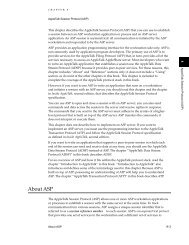URL Loading System Programming Guide - Apple Developer
URL Loading System Programming Guide - Apple Developer
URL Loading System Programming Guide - Apple Developer
You also want an ePaper? Increase the reach of your titles
YUMPU automatically turns print PDFs into web optimized ePapers that Google loves.
About the <strong>URL</strong> <strong>Loading</strong> <strong>System</strong><br />
At a Glance<br />
Relevant Chapter: “Handling Redirects and Other Request Changes” (page 50)<br />
Authentication and Credentials<br />
Some servers restrict access to certain content, requiring a user to authenticate by providing some sort of<br />
credentials—a client certificate, a user name and password, and so on—in order to gain access. In the case of<br />
a web server, restricted content is grouped into a realm that requires a single set of credentials. Credentials<br />
(certificates, specifically) are also used to determine trust in the other direction—to evaluate whether your app<br />
should trust the server.<br />
The <strong>URL</strong> loading system provides classes that model credentials and protected areas as well as providing secure<br />
credential persistence. Your app can specify that these credentials persist for a single request, for the duration<br />
of an app’s launch, or permanently in the user’s keychain.<br />
Note: Credentials stored in persistent storage are kept in the user’s keychain and shared among all<br />
apps.<br />
The NS<strong>URL</strong>Credential class encapsulates a credential consisting of authentication information (user name<br />
and password, for example) and persistence behavior. The NS<strong>URL</strong>ProtectionSpace class represents an area<br />
that requires a specific credential. A protection space can be limited to a single <strong>URL</strong>, encompass a realm on a<br />
web server, or refer to a proxy.<br />
A shared instance of the NS<strong>URL</strong>CredentialStorage class manages credential storage and provides the<br />
mapping of an NS<strong>URL</strong>Credential object to the corresponding NS<strong>URL</strong>ProtectionSpace object for which<br />
it provides authentication.<br />
The NS<strong>URL</strong>AuthenticationChallenge class encapsulates the information required by an NS<strong>URL</strong>Protocol<br />
implementation to authenticate a request: a proposed credential, the protection space involved, the error or<br />
response that the protocol used to determine that authentication is required, and the number of authentication<br />
attempts that have been made. An NS<strong>URL</strong>AuthenticationChallenge instance also specifies the object that<br />
initiated the authentication. The initiating object, referred to as the sender , must conform to the<br />
NS<strong>URL</strong>AuthenticationChallengeSender protocol.<br />
NS<strong>URL</strong>AuthenticationChallenge instances are used by NS<strong>URL</strong>Protocol subclasses to inform the <strong>URL</strong><br />
loading system that authentication is required. They are also provided to the delegate methods of<br />
NS<strong>URL</strong>Connection and NS<strong>URL</strong>Download that facilitate customized authentication handling.<br />
2013-10-22 | Copyright © 2003, 2013 <strong>Apple</strong> Inc. All Rights Reserved.<br />
11
















